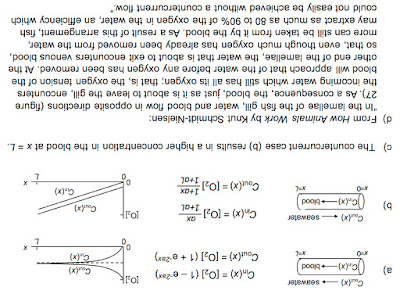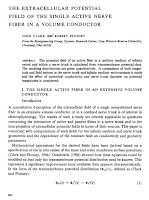I also hope that research workers in biology and medicine will find it a useful reference to brush up on the physics they need or to find a few pointers to the current literature in a number of areas of biophysics. (The bibliography in each chapter is by no means exhaustive; however, the references should lead you quickly into a field.)Below is a list of my favorite dozen articles cited in IPMB. I am only considering those published in journals; books and book chapters are another story. This is not a list of the most important papers, nor the best written papers, nor the most cited papers. These are my personal favorites. Let’s count’em down to number one!
12. Barker AT, Jalinous R, Freeston IL (1985) Non-invasive magnetic stimulation of the human cortex. Lancet 1(8437):1106–1107
This paper founded the field of transcranial magnetic stimulation, which is a topic I worked on when at the National Institutes of Health in the 1990s. See here for more about Tony Barker. The Lancet is one of England’s top medical journals; think of it as a British version of The New England Journal of Medicine.11. Lubin JH (1999) Response to Cohen’s comments on the Lubin rejoinder. Health Phys 77(3):330–332
Russ and I cite a back-and-forth series of letters and replies by Bernard Cohen and Jay Lubin regarding the health effects of low levels of radiation. Although these authors address a serious issue and each has a strong opinion, my impression is that they had a little fun with this exchange, at least when making up the titles. Health Physics is the official journal of the Health Physics Society.10. Mermin ND (1994) Stirling’s formula! Am J Phys 52: 362–365.
I am cheating a little bit with this paper. It wasn’t cited in one of the list of references found at the end of each chapter in IPMB, but rather in a footnote of Appendix I. I included it because David Mermin is my favorite writer of physics, and I couldn’t bear to leave him off the list. Also, the article appeared in my favorite journal, the American Journal of Physics. Finally, the title contains an exclamation point (a subtle pun)!9. Foster KR, Moulder JE (2013) Wi-Fi and health: review of current status and research. Health Phys 105(6):561–575
Ken Foster and John Moulder have been fighting the good fight for years, debunking pseudoscience about the biological effects of weak electric and magnetic fields. This 2013 paper, published in Health Physics, honors their body of work. We need more from these two.8. West GB, Brown JH, Enquist BJ (1999) The fourth dimension of life: fractal geometry and allometric scaling of organisms. Science 284:1677–1679.
One of my favorite chapters in IPMB, Chapter 2, is about the exponential function. It discusses Kleiber’s law: metabolic rate scales as mass to the ¾ power. Why ¾? This is a long-standing and fundamental question in biology. Geoffrey West and his collaborators offer a possible explanation. The paper was published in Science, the academic journal of the American Association for the Advancement of Science. It is perhaps the most famous scientific journal.7. Glide-Hurst CK, Maidment ADA, Orton CG (2010) Point/counterpoint: Ultrasonography is soon likely to become a viable alternative to x-ray mammography for breast cancer screening. Med Phys 37:4526–4529
The journal Medical Physics publishes a Point/Counterpoint article ever month, where prominent medical physicists debate a controversial issue. They are fun to read and a great teaching tool. Carri Glide-Hurst is a medical physicist working at Henry Ford Hospital in Detroit and is the mentor for an Oakland University graduate student, so she gets points for being part of the home team.6. Hämäläinen M, Hari R, Ilmoniemi RJ, Knuutila J, Lounasmaa OV (1993) Magnetoencephalography—theory, instrumentation, and applications to noninvasive studies of the working human brain. Rev Mod Phys 65(2):413–497
This review article on magnetoencephography by a group of Finnish scientists is so good that I still refer students to it even though it is nearly 25 years old.5. Clark J, Plonsey R (1968) The extracellular potential field of a single active nerve fiber in a volume conductor. Biophys J 8:842–864
John Clark and Robert Plonsey’s paper on the extracellular potential of a nerve axon influenced my work as a graduate student. Plonsey was a giant in the field of bioelectricity, Clark was his graduate student, and the Biophysical Journal is one of the top scientific journals publishing papers at the intersection of physics and biology.4. Hobbie RK (1973) The electrocardiogram as an example of electrostatics. Am J Phys 41:824–831
This is one of several articles Russ published about medical and biological physics, which ultimately led to his writing IPMB.3. Basser PJ, Mattiello J, LeBihan D (1994) MR diffusion tensor spectroscopy and imaging. Biophys J 66:259–267
In this paper Peter Basser and his coworkers invented MRI Diffusion Tensor Imaging. Peter’s office was just down the hall from mine when we both worked at the National Institutes of Health, and I can remember the morning he brought in a chunk of pork to do the experiments described in this article. I also knew James Mattiello at NIH; he was one of the first graduates of the Oakland University Medical Physics PhD Program.2. Hodgkin AL, Huxley AF (1952) A quantitative description of membrane current and its application to conduction and excitation in nerve. J Physiol 117:500–544
Every semester I give this classic paper to the students in my Biological Physics class, and we go through it figure by figure when studying Chapter 6 in IPMB. It is truly a Nobel Prize quality paper.1. Purcell EM (1977) Life at low Reynolds number. Am J Phys 45:3–11
This article is a gem: Wonderfully written by a Nobel Prize winner, charming hand-drawn figures, and published in my favorite journal.


















